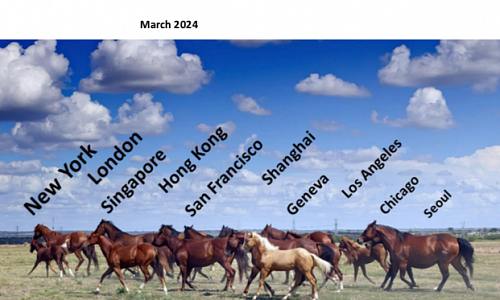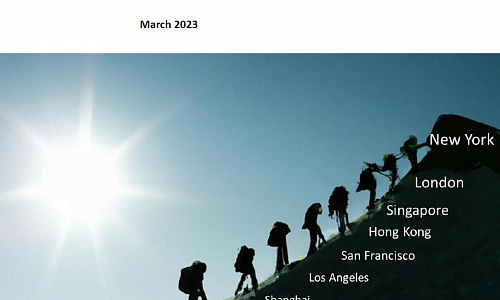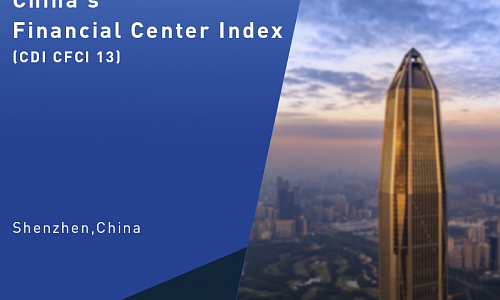Trilateral Journalist Delegation from China, Japan and South Korea Visits CDI
 Journalist delegation from China, Japan and South Korea visited CDI on June 16. Mr. Zheng Yujie, Director of Information and Communications Department, Mr. Zhoulin, Director of Innovation and Industry Research Center, and Mr. Liu Guohong, Director of Finance and Modern Industry Research Department, exchanged views with the delegation on the topics of China Manufacturing 2025, innovative industries in Shenzhen, China's performance in Industry 4.0, the obstacles to the development of China's manufacturing industry, the status quo and prospect of Shenzhen's innovative industries, and how to further their economic cooperation among China, Japan and South Korea.
Journalist delegation from China, Japan and South Korea visited CDI on June 16. Mr. Zheng Yujie, Director of Information and Communications Department, Mr. Zhoulin, Director of Innovation and Industry Research Center, and Mr. Liu Guohong, Director of Finance and Modern Industry Research Department, exchanged views with the delegation on the topics of China Manufacturing 2025, innovative industries in Shenzhen, China's performance in Industry 4.0, the obstacles to the development of China's manufacturing industry, the status quo and prospect of Shenzhen's innovative industries, and how to further their economic cooperation among China, Japan and South Korea.
China’s Experiences in Special Economic Zones Boost the Economic Transformation in the Middle East
 Author: Zeng Manyuan, Research Assistant, Department of Regional Development Planning, CDI Wang Zhen, Research Associate, Department of Regional Development Planning, CDI
Author: Zeng Manyuan, Research Assistant, Department of Regional Development Planning, CDI Wang Zhen, Research Associate, Department of Regional Development Planning, CDI
Editor’s Note: Countries along the "Belt and Road" in the Middle East regards the establishment of special economic zones as a viable path to mitigating troubles in the petroleum sector and realizing economic transformation. The successful model and experiences of the Shenzhen Special Economic Zone, has been highly regarded by the government of Kuwait.
Production capacity and mutual investments are priorities in the course of the joint establishment of the "Belt and Road" with special economic zones becoming an effective platform.
First of all, the establishment of special economic zones will function as a vital platform for Sino-Kuwaiti joint efforts in building the "Belt and Road". Kuwait has always been a steadfast supporter for the “Belt and Road” initiative. In order to alleviate current predicament of the oil industry and achieve economic transformation, the government of Kuwait has made plans for the projects of Silk City and five-island comprehensive development zones with an intention to leverage China's advanced experiences in building special development zones. Furthermore, the integrated management model for special economic zones is going to be a paramount subject for Kuwait to study from. Strategic planning, rules and policies, investment and financing, development and construction, and operation management are all pivotal to the overall construction and planning of the special economic zones. Rules and policies related to the general operation of special economic zones will directly affect the zone's investment and industrialization.
Last but not least, the life-cyclic management of special economic zones will facilitate Sino-Kuwaiti joint efforts in building the "Belt and Road". The Kuwaiti government needs to ensure that the national development strategy is supportive for the establishment of special economic zones and to stipulate rules and policies which will improve the investment environment of the special economic zones. The objectivity and rationality of the special economic zones should be considered as the top priority in the early stage of the planning. What’s more, industries featured by the Sino-Kuwaiti production capacity cooperation should also be arranged in the special economic zone in the phase of attracting investment. Kuwait needs to improve the government efficiency and management in the special economic zones based on the overall planning so as to optimize the investment environment of the zones.
Growth is Under Pressure

Growth is relatively stable but still facing downward pressure. The value added for major industrial firms up 6.5% y/y in May – flat on April, and slightly below that of Q1, but still higher than all quarters of 2016. But as the key to growth, fixed asset investment was up 7.9% y/y, decreased 1.3 pps from Q1 after showing decreased trend for two consecutive months. Although current investment growth is not at its lowest rate, the adjusted rate below all quarters of last year after factoring in last year’s low base number. We therefore expect some pressure on future aggregate growth.
M2 reached a record low in May. It rose 9.6% y/y, down 0.9 pps from April, and down 2.2 pps from last May. This is partially due to the deleveraging efforts by monetary policy makers, but it certainly will put pressure on growth. Retail sales of consumption goods were up 10.7% y/y in nominal terms, flat on April. In May, exports grew 8.7% y/y, up 0.7 pps from Q1. Imports rose 14.8% y/y, down 9.8 pps from Q1. Over the medium term, as growth rates for producer prices turn downward, imports will continue to weaken, and might even consequently lead an export slowdown.
CPI was up 1.5% y/y in May, appreciating for three consecutive months, and up 0.3 pps from April. The ex-factory price index rose 5.5% y/y, down 0.9 pps from April. PPI rose 8% y/y, down 1 pps from April. The downward trends of producer prices confirm our previous forecast, and we expect this trend to continue.
The China Foreign Exchange Trade System trading platform, overseen by the Central Bank, announced the introduction of "counter-cyclical factor” into its calculation method of yuan's daily reference rate on May 26th. This will allow it to better reflect supply and demand over the long term, and to partially counter the short-term exchange rate fluctuations. We believe that this change will avoid currency herding, leading to a more fundamentals-based exchange rate. The change will increase the stability of yuan, reducing uncertainties for investors and trading partners. Meanwhile, the size of the FX reserve seems to be stabilizing in recent months, even under current environment while the new round of Fed interest rate hikes. It may be safe enough to expect much less volatility in the RMB exchange rate, at least for the rest of this year.
On Recent Hot Topics of Macro Economy
Author: Fan Gang, President of CDI
Editor’s Note: Professor Fan Gang had a television exclusive interview with CBN on a series of macroeconomic issues including global market, monetary policy, and foreign exchange rate. Following are edited excerpts from the interview:
 “Loose monetary policy cannot be used to control financial risks.”
“Loose monetary policy cannot be used to control financial risks.”
Bursting credit risks have triggered heated debates since March. Given current supply-demand relationship, a prudent monetary policy shall be in place. Default becomes a natural thing due to high leverage and severe supervision caused by overheated economy. Financial risks need to be controlled, yet a loose monetary policy is not an option.
“Deposit reserve ratio reduction is not equivalent to monetary policy easing.”
At present, China’s foreign exchange reserves have been cut down. Therefore, reserve ratio has to be lowered to maintain quantity of money, which is a neutral rather than loose monetary policy.
“It is not about whether to maintain FX reserves or exchange rate.”
There is no need to protect FX reserves as China's foreign exchange reserves dropped below $3 trillion due to RMB internationalization progress like yuan’s inclusion in SDR basket and the fact that United States treasury bonds are low in efficiency and returns. Meanwhile, the renminbi will move towards a more flexible exchange rate rather than a fixed one that is pegged to the US dollar. Therefore, maintaining exchange rate is just groundless talk. Overnight foreign exchange reserve fluctuation is unwanted for any country. Certain measures will be taken to ensure stable transition in exchange rate or FX reserves.
“Be prepared for short-term appreciation and long-term depreciation of the US dollar.”
After Trump came to power, Sino-US relations are filled with "uncertainties", but several things are clear. First, Trump can no longer accuse China of currency manipulation; second, the Trump administration will increase trade frictions between the two countries, but will not launch a full-fledged trade war against China; third, Trump will reinforce public opinions through tax cuts and infrastructure investment growth. As a result, USD will appreciate in the short run with foreign investments attracted to the US and the prices of crude oil and staple commodities at the international market will be on the rise at the same time. America’s social security expenditure will continue to grow and its deficit and inflation will see a strong uptrend as a consequence of Trump’s tax cuts and intensified infrastructure investment. All this is likely to lead to depreciation of the US dollar.
Trade policy under the Trump administration
Author: Stephen Olson, special contribution to CDI. Research Fellow at the Hinrich Foundation
Editor’s Note: There are four main issues regarding trade policy and the Trump administration to address: process and power, the key people on the Trump trade team and their perspective, recent policy developments and likely scenarios.
 There are four main issues regarding trade policy and the Trump administration to address. What authority does President Trump actually have to implement his trade agenda? Who are the key people on the Trump trade team and what is their perspective on international trade? How should we interpret several recent policy developments? What are some of the most likely potential scenarios moving forward?
There are four main issues regarding trade policy and the Trump administration to address. What authority does President Trump actually have to implement his trade agenda? Who are the key people on the Trump trade team and what is their perspective on international trade? How should we interpret several recent policy developments? What are some of the most likely potential scenarios moving forward?
Process and power
As a candidate and in the early days of his administration, President Trump made a number of very provocative policy pronouncements about what he would like to do in the area of international trade. This raises the obvious question: does he actually have the authority to do the things that he is talking about? The short answer is: yes, he does.
The US Constitution provides authority to manage international trade to the US Congress. However, over the years the US Congress has delegated a significant amount of authority back to the president. Section 301 of the Trade Act of 1974 gives the president the authority to take retaliatory action, such as tariffs, if he determines that US commercial interests are being damaged by unfair or discriminatory trade practices from foreign countries.
Although President Trump doesn’t have unlimited power when it comes to international trade, he does have very substantial power to implement most— if not all— of what he has talked about on his trade agenda.
People and perspectives
There are several critical individuals to discuss on the Trump trade team: Wilbur Ross, Commerce Secretary; Robert Lighthizer, nominated US Trade Representative; Peter Navarro, head of the National Trade Council, and Gary Cohn, Director of the National Economic Council.
Wilbur Ross is a very successful private equity investor with a lot of experience in China and very clear-cut viewpoints on China. During his Senate confirmation hearings, Ross expressed the viewpoint that China is the most protectionist large country in the world and believes that the United States should only open its borders to those countries that “play by the rules”.
Robert Lighthizer is the well-qualified nominee with real government experience for US Trade Representative. From a philosophical point of view, he feels that the United States has outdated, over-idealized notions of free trade while the rest of the world isn’t playing by the same rules. He certainly advocates a more aggressive stance on China.
Peter Navarro serves as the head of the National Trade Council—a newly created position in the White House. Navarro is most famous, or infamous, for a book and subsequent documentary titled “Death by China”, which does not provide a favorable look at China’s trade policies. He also advocates a much tougher, aggressive trade stance vis-a-vis China.
Gary Cohn is the head of the National Economic Council. He holds more traditional pro-free trade viewpoints, and has proven to be surprisingly influential in the Trump White House. He can be expected to attempt to moderate some of the harder-line trade stances taken by his colleagues.
In general, these gentlemen— who will form the core group of the Trump administration on international trade— are deeply experienced and have very well developed viewpoints on international trade.
Recent policy developments
President Trump has recently signed a number of Executive Orders (EO) related to international trade. These EOs call for a tighter enforcement of AD/CVD cases, a review of countries with large trade surpluses with the US, an investigation into steel imports, and a review of Buy America provisions in trade agreements. The main themes from the trade policy agenda submitted this year by the Trump Administration are: a seeming willingness to disregard WTO rulings, stricter enforcement of trade laws, and a greater use of leverage in negotiating trade agreements.
Potential scenarios
One of the first scenarios from the Trump administration is a much different approach to trade agreements. Under the Obama administration and in most administrations in the past 30 years, geostrategic considerations have played a very high role in the conduct of US trade policy. Case and point is the Trans-Pacific Partnership (TPP). This will change under the Trump administration. Geostrategic considerations will be significantly downgraded and perhaps even thrown out the window. Trade policy and trade agreements will now be conducted on the basis of whether they meet the following three criteria: they increase US growth rates, reduce the US trade deficit and strengthen the US manufacturing sector. The focus will be on economics. The Trump administration is also likely to put their emphasis on bilateral negotiations rather than multilateral or regional agreements for the reasons of greater degree of leverage and higher common denominator approach in bilateral negotiations.
The second potential scenario from the Trump administration is a more aggressive push back against perceived unfair trade practices. The first is an increase in antidumping and countervailing duties cases filed against trading partners. The second is levying punitive tariffs during the course of trades. The third is considering currency manipulation as an unfair export subsidy which would further result in the imposition of tariffs. Finally, the Committee on Foreign Investment in the United States (CFIUS) already has pieces of draft legislation circulating around Capitol Hill that would toughen the enforcement and monitoring of investments moving into the United States.
For the third potential scenario, it is extremely likely that there will be a renegotiation of the North American Free Trade Agreement (NAFTA). Some of the most likely issues to be negotiated include, first and foremost, tighter rules of origin under the Trump administration. Considering that government procurement provisions in NAFTA circumscribe the ability of governments to give preferences to domestic suppliers. Thus, the Trump administration will likely be looking to weaken the government procurement provisions in NAFTA so it has more latitude to implement “Buy American, Hire American” policies. The other area is wages, Wage issues, along with broader labor and environmental issues are likely to come up in a renegotiation of NAFTA.
Renegotiating NAFTA is actually a very healthy exercise. The NAFTA agreement is 23-years-old, so it makes sense to review what works well, what doesn’t work well, and see if there are things to improve or update. The likelihood is that the three countries will be able to agree to a very reasonable set of adjustments that result in an improved NAFTA moving forward.
The fourth potential scenario centers on US-China relations. While volatility is certainly not a foregone conclusion, it is a possibility. If China and the US have trade conflicts, what are some of the tools China has in its toolbox to strike back against the United States?
Antidumping and countervailing duties are probably tool number one. China has learned very well from both the US and the European Union by constructing an antidumping and countervailing duty law. This law is highly effective and capable of inflicting serious damage. If a spate of cases is filed by the US against China, it is likely to see China filing a number of antidumping or countervailing duty cases against the United States, which would have very specific economic impact.
The other tool that China has to respond with would be using its regulatory regime to tighten the screws on US businesses doing business in China. The anti-monopoly law could be used, particularly in the areas of pharmaceuticals, smart manufacturing, and medical devices.
Another thing that the Chinese government can do is to use its influence in the economy—through state-owned enterprises—to change purchasing decisions. For example, a number of very expensive airplane orders that previously would have gone to Boeing could now go to Airbus.
The final item, depending on what action the US takes, is the Chinese government could be on firm ground to raise dispute settlements in the WTO. Of course, each case would need to be decided on its own merits, but that is a possibility.
Trade policy under the Trump administration is going to diverge very sharply from a number of the fundamental principles that has guided US trade policy for 30 years. At this point, it is entirely premature to speculate what the results of this new approach to trade will be. But for whatever it is worth, keep your seatbelts fastened because we could be hitting a period of turbulence.
The Future Trend of Xiongan New Area
Author: Song Ding, Senior Research Fellow of CDI
Editor’s Note: There are several issues to be considered as for Xiongan New Area which is aimed at accepting non-capital functions from Beijing, exploring a new model of optimized development in densely-populated areas, and restructuring the urban layout in the Beijing-Tianjin-Hebei region.
 The Establishment of Xiongan New Area is expected to help phase out some non-capital functions from Beijing, explore a new model of optimized development in densely-populated areas, and restructure the urban layout in the Beijing-Tianjin-Hebei region. However, there are several issues to be considered.
The Establishment of Xiongan New Area is expected to help phase out some non-capital functions from Beijing, explore a new model of optimized development in densely-populated areas, and restructure the urban layout in the Beijing-Tianjin-Hebei region. However, there are several issues to be considered.
Strategic Positioning and Industrial Development
The most practical functional positioning of the Xiongan New Area is to accept non-capital functions unloaded from Beijing and to foster a new growth engine for the Beijing-Tianjin-Hebei city clusters.
In transferring the "non-capital" functions out of Beijing, it is essential to relocate state-owned enterprises especially the lower-end traditional industry chains of these enterprises. If these enterprises and industries were simply moved to the Xiongan New Area, then the new area would be home to the unwanted and lower-end industries and over-staffed state-owned enterprises of Beijing. This would be going against the positioning of the new area. Despite institutional reform and industrial upgrading in the process of the relocation, it would be extremely difficult given the fact that these industries and enterprises have been developing for a very long time in Beijing with a lot of deep-seated problems. Major changes are unlikely to take place with the sudden and mass relocation to the new area.
Lessons from the Development of the Binhai New Area and Caofeidian
It is not the first time to establish a state-level development zone in the Beijing-Tianjin-Hebei region. Years ago, Tianjin set up the Binhai New Area with the hopes that it would become a leader in the integrated growth of the Beijing-Tianjin-Hebei region. Now more than ten years have passed, but the Binhai New Area has failed to achieve the initial strategic goals in terms of institutional reform and regional development. As to Caofeidian located in Tangshan, it also cherished the vision of transferring non-essential functions of Beijing, only to soon fall into predicament because of disadvantages in location, population, capital, industrial structure and operation mechanism, etc.
The development of the Binhai New Area and Caofeidian sends an important signal to the development of the Xiongan New Area, which is currently in the limelight. The new area is set up against the backdrop of huge pressure for transformation and upgrading of the Chinese economy. It is necessary to learn from the experiences in the development of the Binhai New Area and Caofeidian.
Paralleling Shenzhen Economic Zone and Pudong New District
The aim of Xiongan New Area is to rival two famous regions, namely, the Shenzhen Economic Zone and Pudong New District. However, this does not mean that the new area can copy the experience of Shenzhen and Pudong.
In terms of regional layout, Shenzhen borders Hong Kong, whose market economy and global background played a fundamental role in promoting Shenzhen’s growth, while Pudong is situated in Shanghai, the biggest financial center of China. Xiongan is different, as it is over 100 km away from Beijing and Tianjin. From the perspective of urbanization, Xiongan features a lower starting point and greater difficulties.
Time-wise, Shenzhen and Putong rose in the 1980s and 1990s respectively, at a time of China’s reform and opening up, during which the annual GDP growth rate could soar to a startling 20% and even 30%. The Xiongan New Area, however, is set up at a time of economic transformation and upgrading, which means that much of the experience of Shenzhen and Pudong are no longer applicable in the current situation.
In terms of industries, at the early stage of its development amidst an extremely weak national economy, Shenzhen was able to make full use of industries, technologies, capital and management of Hong Kong, all of which were the most advanced in China at that time. Pudong is home to advanced industries in Shanghai, including large numbers of headquarters of foreign-funded businesses. In contrast, the industries labeled “non-capital functions” of Beijing, most of which are neither high-tech nor advanced, would be moved to Xiongan. \
It is evident that if Xiongan is to parallel Shenzhen and Pudong, it should not only undertake the “non-capital functions” of Beijing, but also should build industry chains of high standards. This, however, poses great challenges.
Development Mode
The development mode of the Xiongan New Area shall firstly be supported by dedicated state policies, including the preferential policies in tax and personal income. Secondly, decentralization of power is needed to enable pilot reform by adopting a negative list. Thirdly, it shall build an institutional mechanism that truly depends on market. Fourthly, an industry framework shall be built to promote advanced industries as economic engines. Fifthly, it shall allow for experiments in legislation and law-based management. Lastly, a fundamental pattern featuring small government and big market shall be in place.
Xiongan is situated near the capital which has strong administrative power in northern China, where the role of market is relatively weak It is therefore not an easy task to break away from the ineffective development mode in the past. The only way out, nevertheless, is to tackle these difficulties and create a new development mode in northern China.
Environmental Security
Smog is prevalent across the Beijing-Tianjin-Hebei region, and Xiongan is no exception. Xiongan is home to Baiyangdian, the largest lake in North China, which had once dried up. Upon setting up, the new area faces daunting challenges in environmental protection. In the coming years, Xiongan will enter into a stage of rapid development, which will further increase the pressure on the environment. Globally, there have never been cases of vigorously developing economy which keeps the environment intact at the same time. Challenges for the environmental regulators of Xiongan are severe.
China’s Economic Growth and Internet Consumer Finance
Author: Fan Gang, President of CDI
Editor’s Note: China’s economy has seen strong performance in the first quarter but still needs a few years for consolidation due to overcapacity and other problems caused by an overheated economy in the past. After that, China’s economy shall enter into a new round of growth, hopefully within the proper range of 7%-8%. China’s economic growth still has a long way to go since consumption boom is just beginning.
 A major engine for China’s economy is the constant rise of consumption, which has been growing at a faster rate than ever before. Consumption now accounts for around 62% of the GDP, up from around 52% in the past, and individual consumer spending is now around 45%, up from 35% in the past. Compared to developed countries, China still has huge potential. Consumption is taking up an ever bigger share of the economy and China’s consumption boom is just beginning. This trend is in line with the rule of economic development regarding the shift from production, savings and investment at the earlier stage of development to consumption at the later stage. The rise of China’s middle class and per capita GDP naturally contributes to the rise of various consumption. Despite the serviced-based consumption such as tourism and fitness, China's consumption is still largely characterized by a fairly huge proportion of material consumption. Therefore, China's manufacturing industry still has tremendous potential for development.
A major engine for China’s economy is the constant rise of consumption, which has been growing at a faster rate than ever before. Consumption now accounts for around 62% of the GDP, up from around 52% in the past, and individual consumer spending is now around 45%, up from 35% in the past. Compared to developed countries, China still has huge potential. Consumption is taking up an ever bigger share of the economy and China’s consumption boom is just beginning. This trend is in line with the rule of economic development regarding the shift from production, savings and investment at the earlier stage of development to consumption at the later stage. The rise of China’s middle class and per capita GDP naturally contributes to the rise of various consumption. Despite the serviced-based consumption such as tourism and fitness, China's consumption is still largely characterized by a fairly huge proportion of material consumption. Therefore, China's manufacturing industry still has tremendous potential for development.
China’s consumption growth is highly dependent on three social groups. The first consumer group is the younger generation. Firstly, young people are confident in their future income. Secondly, many young people are the only child in their family, which means they might have four elders in the family who tend to save money for the youngest generation and share a great deal of their burdens, providing them with the consumption support. The second consumer group is the financially well off retirees, who, with adequate time and money, are prepared to travel and enjoy life. The third consumer group is middle-age people. With the introduction of the second-child policy, education and housing in the school district will give a huge impetus to consumption. Therefore, the next round of China’s economic growth will rely more on consumption instead of investment.
The internet represents the greatest revolution in science and technology, reduces information cost, and brings new impetus for development. The internet successfully connects credit, risk, and data, promoting the growth of consumer finance and improving the ecosystem of the financial sector. Preferred terminology is “industries plus the internet”, and not “internet plus industries”. The regulatory authorities shall also actively adapt to new advances in technology so as to promote sustainable and healthy development of industries.
New Urbanization Strategy to Contain a Housing Bubble

GDP was up 6.9% y/y in Q1, its fastest growth since last year, and up 0.1 pps from Q4 2016. However, given the end of producer price appreciation, and real estate market re-tightening, we expect this recovery to be temporary.
Industrial output rose 6.8% y/y, up 0.7 pps from Q4. March saw a particularly strong spike, up 7.6% y/y, its highest rate since 2015. Fixed asset investment rose 9.2% y/y, up 1.4 pps from Q4, when adjusted growth was only 4.5% y/y, after factoring in the Q1 investment price boom, down 1.9 pps.
Retail sales of consumption goods rose 10% y/y in Q1 in nominal terms, down 0.6 pps from Q4. The real term growth rate was 8.8% y/y in Q1, down 0.3 pps. Trade is balancing in Q1, with the trade surplus falling -47.8% y/y, while exports grew 8.2% y/y. Imports grew 24% y/y, up 21.3 pps, mainly driven by producer price appreciation, reflected in the commodity goods imports climb.
CPI was up 0.9% y/y in March, down 1.2 pps from December 2016. The large drop came mainly in the food category. Food prices fell -4.4% y/y, down 6.8 pps from December. In March, the ex-factory price index for industrial goods rose 7.6% y/y, down 0.2 pps from February. PPI rose 10% y/y, up only 0.1 pps from February. These two m/m growth rates also show obvious declines. We expect both growth rates to decline further.
M1 and M2 were up 18.8% y/y and 10.6% y/y at the end of March, down 2.6 and 0.7 pps from last December respectively. Other major financial indicators are also weakening.
The CCP central committee and state council announced in an April 4th joint statement that they plan to build a massive new city outside Beijing. Xiong’an is to be “three times the size of New York, and aims to achieve the same importance as Shenzhen and Shanghai Pudong, the announcement said. Simultaneously, residential land availability in Beijing is to expand significantly. These two policies indicate that China’s new approach to controlling housing bubbles as people rush to big cities will be increasing land supply in large urban centers, and building satellite cities nearby, instead of prioritizing small-city development. We view this as a positive measure to alleviate housing price appreciation pressure, while dealing with excessive housing supply in small cities, more and more people are leaving as they migrate to large urban centers.
Dr. Liu Rongxin Attends Seminar on Sino-Kuwait Joint Efforts for Belt and Road Initiative
 Dr. Liu Rongxin, General Director of the Department of Regional Development Planning at CDI, gave a keynote speech on China’s experience with special economic zones (SEZs) and the success story of Shenzhen SEZ at the Seminar on Sino-Kuwait Joint Efforts for the Belt and Road initiative which was co-hosted by Kuwait University and Embassy of China in Kuwait from April 18 to 19 in Kuwait City.
Dr. Liu Rongxin, General Director of the Department of Regional Development Planning at CDI, gave a keynote speech on China’s experience with special economic zones (SEZs) and the success story of Shenzhen SEZ at the Seminar on Sino-Kuwait Joint Efforts for the Belt and Road initiative which was co-hosted by Kuwait University and Embassy of China in Kuwait from April 18 to 19 in Kuwait City.
Discussions centered on the Belt and Road initiative, China-Kuwait relations, China’s experience with SEZs, and the development of the five islands in Kuwait, were held among Mr. Wu Sike, the Chinese special envoy to the Middle East, Chinese experts on the economics and the Middle East, Chinese business representatives in Kuwait and political, economic and law experts from Kuwait. Kuwaiti government officials, such as Sheikh Nasser Sabah Al-Ahmad Al-Sabah, the Kuwaiti Minister of Amiri Diwan, also attended the opening ceremony of the seminar.








